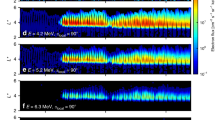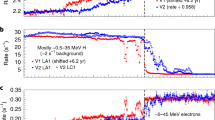Abstract
THE theory of the allowed cone of electrically charged primary cosmic rays, developed in a number of recent papers by Lemaître and Vallarta1, is competent to account for the longitude effect if due regard is paid to the fact that the earth's centre does not coincide with its magnetic centre2. Assuming Schmidt's determination3 of the latter and, with Clay, an exponentially decreasing energy distribution of primary charged particles, it has been shown that the longitude effect along the geomagnetic equator should be roughly sinusoidal with maximum at geographic longitude 12° W. and minimum at 168° E. ; the intensity difference between maximum and minimum is calculated to be about 8 per cent. More recent calculations of the position of the earth's magnetic centre (Bruins4, Bartels5) have somewhat revised Schmidt's earlier result, but the theoretical longitude effect is not much affected thereby. The longitude of the maximum and minimum depends only on the co-ordinates of the earth's magnetic centre, particularly on its longitude ; the intensity difference between the maximum and minimum is closely connected with the distance between the earth's centre and its magnetic centre, to a lesser extent with the energy distribution of primary particles.
This is a preview of subscription content, access via your institution
Access options
Subscribe to this journal
Receive 51 print issues and online access
$199.00 per year
only $3.90 per issue
Buy this article
- Purchase on Springer Link
- Instant access to full article PDF
Prices may be subject to local taxes which are calculated during checkout
Similar content being viewed by others
References
Lemaître, G., and Vallarta, M. S., Phys. Rev., 43, 89 (1933) ; 49, 719 (1936) ; 50, 493 (1936). Lemaître, G., Ann. Soc. Sci. Bruxelles, 54, 162 (1934). Bouckaert, L., idem, 54, 174 (1934).
Vallarta, M. S., Phys. Rev., 47, 647 (1935).
Schmidt, A., Z. Geophys., 2, 38 (1926).
Bruins, E. M., Physica, 2, 887 (1935).
Bartels, J., Terr. Mag. and Atmos. Elec., 41, 225 (1936).
Hoerlin, H., Z. Phys., 102, 666 (1936).
Compton, A. H., Rev. Sci. Inst., 7, 73 (1936).
Millikan, R. A., and Neher, H. V., Phys. Rev., 50, 24 (1936).
Clay, J., van Alphen, P. M., T Hooft, C. G., Physica, 1, 829 (1934).
Bowen, I. S., Millikan, R. A., Korff, S. A., and Neher, H. V., Phys. Rev., 50, 579 (1936).
Clay, J., Bruins, M. E., Wiersma, J. T., Physica, 3, 746 (1936).
Johnson, T. H., private communication to the author.
Author information
Authors and Affiliations
Rights and permissions
About this article
Cite this article
VALLARTA, M. Longitude Effect of Cosmic Radiation and the Position of the Earth's Magnetic Centre. Nature 139, 24–25 (1937). https://doi.org/10.1038/139024b0
Issue Date:
DOI: https://doi.org/10.1038/139024b0
Comments
By submitting a comment you agree to abide by our Terms and Community Guidelines. If you find something abusive or that does not comply with our terms or guidelines please flag it as inappropriate.



